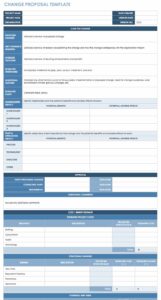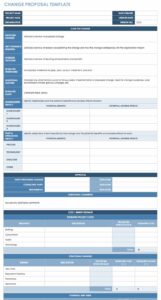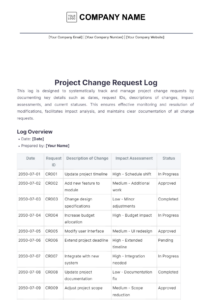Utilizing this structured approach offers several advantages. It fosters clear communication among stakeholders, reduces the risk of miscommunication and errors, and promotes accountability. The ability to track the progress of each modification ensures transparency and simplifies auditing. Furthermore, the historical record of changes becomes invaluable for future analysis, problem-solving, and continuous improvement initiatives.
This foundation of organized change management is crucial for successful project delivery and operational efficiency. Exploring specific elements within these documents, such as required fields, approval workflows, and integration with other systems, provides a deeper understanding of how they support effective organizational change management.
Key Components of a Change Request Log
Effective change management relies on comprehensive documentation. A well-structured log requires specific components to ensure clarity, traceability, and informed decision-making.
1. Unique Identifier: A distinct number or code assigned to each request allows for easy tracking and referencing throughout its lifecycle.
2. Request Date: Recording the submission date establishes a chronological record of requests and aids in prioritizing tasks.
3. Requester Information: Identifying the individual or team initiating the change provides context and points of contact for clarification or follow-up.
4. Description of Change: A clear and concise explanation of the proposed modification, including its purpose and scope, is essential for understanding the request.
5. Justification: The rationale behind the change, explaining the need and expected benefits, helps stakeholders evaluate its value and potential impact.
6. Affected Systems/Areas: Specifying the components or areas impacted by the change helps assess potential risks and dependencies.
7. Implementation Plan: Outlining the proposed steps for implementing the change, including timelines and resource allocation, provides a roadmap for execution.
8. Approval Status: Tracking the approval process, including relevant stakeholders and their decisions, ensures appropriate authorization and accountability.
These elements ensure comprehensive documentation of each modification request, enabling efficient processing, informed decision-making, and effective change implementation. Maintaining meticulous records facilitates transparency and provides valuable insights for future planning and process improvement.
How to Create a Change Request Log Template
Developing a standardized template ensures consistency and efficiency in managing change requests. A well-defined structure facilitates clear communication and informed decision-making throughout the change management process.
1. Define Scope and Purpose: Establish the specific types of changes the log will track and its intended use within the organization. This clarifies the required fields and level of detail.
2. Determine Required Fields: Select essential data points for tracking each request, such as a unique identifier, request date, requester information, description of change, justification, affected areas, implementation plan, and approval status.
3. Choose a Format: Select a suitable format, such as a spreadsheet, database, or dedicated software tool. Consider accessibility, collaboration features, and integration with existing systems.
4. Design the Layout: Organize the chosen fields in a clear and logical manner, ensuring ease of data entry and readability. Use clear headings and consistent formatting.
5. Establish Approval Workflows: Define the approval process, including roles and responsibilities, to ensure appropriate authorization for each change request.
6. Implement Version Control: Maintain version history to track modifications to the template itself, ensuring clarity and preventing confusion.
7. Train Users: Provide training to all stakeholders on how to use the template effectively, ensuring consistent data entry and adherence to established procedures.
8. Regularly Review and Update: Periodically review the template’s effectiveness and make necessary adjustments to align with evolving organizational needs and best practices.
A standardized approach to documenting change requests promotes effective communication, facilitates informed decision-making, and supports successful change implementation. A well-designed template streamlines the process, minimizes errors, and provides valuable data for continuous improvement.
Standardized documentation through a dedicated template provides a critical foundation for successful change management. It enables organizations to track proposed modifications systematically, ensuring clear communication, facilitating informed decision-making, and promoting accountability throughout the entire change lifecycle. Key components, including unique identifiers, detailed descriptions, justifications, impact assessments, and approval statuses, contribute to a comprehensive record of each request, fostering transparency and enabling efficient processing. Careful consideration of template design, data fields, and approval workflows is essential for maximizing effectiveness and integration with existing systems.
Effective change management is crucial for organizational agility and success in dynamic environments. Leveraging structured logging processes enhances not only the immediate efficiency of change implementation but also provides valuable data for future analysis, process improvement, and informed strategic planning. Organizations committed to continuous improvement should prioritize the development and consistent utilization of robust change management practices, ensuring adaptability and resilience in the face of evolving challenges and opportunities.


